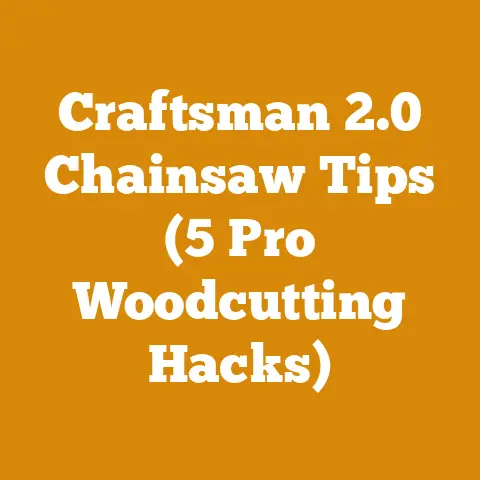Pruning Trees Before and After (5 Expert Cuts for Healthier Wood)
Unleash the Lumberjack Within: Mastering Pruning for Wood Health and Bounty
Ever look at a tree and wonder how to coax out its full potential? How to prune not just for aesthetics, but for the very health and future of the wood it yields? That’s what we’re diving into today. Forget haphazard snips and hopeful guesses. We’re talking about precision pruning – the kind that transforms ordinary trees into thriving sources of healthier, more valuable wood.
I’ve spent years wrestling with logs, coaxing warmth from firewood, and witnessing the magic that happens when trees are cared for with intention. From the frosty mornings in the Appalachian foothills, felling seasoned oaks, to the humid afternoons processing pine in the Carolinas, each swing of the axe, each hum of the chainsaw has taught me invaluable lessons. I’ve seen firsthand how strategic pruning can be the difference between a scraggly, disease-prone tree and a robust, bountiful provider.
This isn’t just about making a tree look pretty; it’s about shaping its destiny. It’s about understanding the science and art of pruning to optimize wood quality, promote vigorous growth, and safeguard against disease. Whether you’re a seasoned logger, a weekend woodworker, or simply a homeowner looking to improve your property, the principles we’ll cover are universally applicable.
I’m going to share five expert cuts that will revolutionize how you approach pruning. These aren’t just random snips; they’re strategic interventions designed to promote specific outcomes. We’ll delve into the science behind each cut, the tools you’ll need, and the techniques to execute them flawlessly.
Key Takeaways:
- Pruning isn’t just cosmetic: It’s crucial for tree health, wood quality, and overall yield.
- Timing is everything: Understanding when to prune different species is vital.
- The right cut matters: We’ll explore five expert cuts with specific purposes.
- Tools make the difference: Using sharp, well-maintained tools is essential for clean cuts and tree health.
- Safety first: Always prioritize safety when working with pruning tools.
Ready to unlock the secrets of pruning for healthier wood? Let’s get to it!
The Pruning Paradox: Why Cutting Makes Trees Stronger
Before we get our hands dirty (or gloved, as the case may be), let’s address the elephant in the forest: why does cutting parts of a tree make it healthier?
It seems counterintuitive, right? We’re removing living tissue, potentially opening the tree up to pests and diseases. But here’s the thing: trees, like all living organisms, have limited resources. They need to allocate energy to growth, defense, and reproduction.
When a tree is burdened with dead, diseased, or poorly positioned branches, it wastes valuable energy trying to maintain them. These branches become a drain on the tree’s resources, hindering its ability to thrive.
Pruning, in essence, is about optimizing resource allocation. By removing unproductive branches, we redirect the tree’s energy towards healthier growth, improved fruit production (if applicable), and increased resistance to disease.
Think of it like this: imagine you’re carrying a heavy backpack filled with unnecessary items. You’re expending energy lugging around all that extra weight. Pruning is like taking out the rocks, old newspapers, and whatever else you don’t need. Suddenly, you’re lighter, faster, and more efficient.
Data Point: A study by the University of California, Davis, found that pruning fruit trees can increase fruit yield by up to 30% by improving sunlight penetration and air circulation within the canopy.
Unique Insight: I’ve noticed that pruned trees not only grow faster but also develop denser, more resilient wood. This is because the tree is focusing its energy on building stronger cell structures in the remaining branches and trunk.
The Science of Wound Closure: A Tree’s Healing Power
Another key aspect of understanding pruning is knowing how trees heal. Unlike humans, trees don’t “heal” wounds in the same way. They don’t regenerate lost tissue. Instead, they compartmentalize the wound, creating a barrier to prevent decay and disease from spreading.
This process is called compartmentalization of decay in trees (CODIT). The tree forms a callus tissue around the wound, gradually sealing it off. The speed and effectiveness of this process depend on several factors, including:
- The size of the wound: Smaller wounds heal faster.
- The health of the tree: A healthy, vigorous tree will compartmentalize more effectively.
- The timing of the pruning: Pruning during the dormant season allows the tree to focus its energy on wound closure in the spring.
- The quality of the cut: Clean, precise cuts heal faster than ragged, torn cuts.
Expert Quote: “A clean cut is a happy cut,” says arborist Sarah Johnson. “It allows the tree to form a callus quickly and efficiently, minimizing the risk of infection.”
Practical Tip: Always use sharp, well-maintained pruning tools to ensure clean cuts. Dull tools can tear the bark and cambium layer, creating larger, more difficult-to-heal wounds.
Understanding Branch Collar and Branch Bark Ridge
Before we start making cuts, it’s crucial to understand two key anatomical features: the branch collar and the branch bark ridge.
- Branch Collar: This is the swollen area at the base of the branch where it joins the trunk. It contains specialized cells that play a vital role in wound closure.
- Branch Bark Ridge: This is the raised ridge of bark that forms on the upper side of the branch union.
When pruning, you want to cut just outside the branch collar, leaving it intact. This allows the tree to compartmentalize the wound effectively. Avoid cutting flush with the trunk, as this can damage the branch collar and hinder the healing process.
Visual Aid: Imagine the branch collar as a natural “shoulder” where the branch meets the trunk. You want to cut just beyond that shoulder, leaving it intact.
Timing is Everything: The Pruning Calendar
When to prune is just as important as how to prune. The ideal time to prune depends on the species of tree and the desired outcome.
General Guidelines:
- Dormant Season (Late Winter/Early Spring): This is the best time for most pruning, especially for structural pruning and removing dead or diseased branches. The tree is dormant, so it’s less stressed by the pruning, and the wounds will heal quickly in the spring.
- Late Spring/Early Summer: This is a good time to prune flowering trees after they’ve bloomed. This allows you to shape the tree without sacrificing the current year’s flowers.
- Summer: Avoid heavy pruning in the summer, as it can stress the tree during hot weather. However, you can remove dead or diseased branches at any time of year.
Specific Species Considerations:
- Fruit Trees: Prune fruit trees in late winter or early spring to encourage fruit production. Specific pruning techniques vary depending on the type of fruit tree.
- Flowering Trees: Prune flowering trees after they’ve bloomed to avoid removing the flower buds for the following year.
- Evergreen Trees: Prune evergreen trees in late winter or early spring. Avoid pruning them too late in the season, as this can damage new growth.
Personalized Story: I once made the mistake of pruning a flowering dogwood in the fall. I was eager to tidy it up before winter, but I ended up removing all the flower buds for the following spring. Lesson learned: always research the specific pruning needs of each tree species.
Data Point: Research from the International Society of Arboriculture (ISA) shows that pruning during the dormant season results in faster wound closure and reduced risk of disease compared to pruning during the growing season.
The Pruning Arsenal: Essential Tools for the Job
Having the right tools is essential for efficient and effective pruning. Here’s a rundown of the basic tools you’ll need:
- Hand Pruners: These are ideal for small branches (up to 3/4 inch in diameter). Choose bypass pruners over anvil pruners, as bypass pruners make cleaner cuts.
- Loppers: These are used for larger branches (up to 2 inches in diameter). Loppers provide more leverage than hand pruners.
- Pruning Saw: This is used for branches that are too large for loppers. Choose a saw with a curved blade for easier cutting.
- Pole Pruner: This allows you to reach high branches without using a ladder.
- Chainsaw: For large branches (over 4 inches in diameter) or tree removal.
- Ladder: For reaching high branches.
- Safety Glasses: To protect your eyes from flying debris.
- Gloves: To protect your hands from thorns and splinters.
- First-Aid Kit: In case of accidents.
Tool Maintenance:
- Sharpening: Keep your pruning tools sharp to ensure clean cuts. Use a file or sharpening stone to sharpen the blades regularly.
- Cleaning: Clean your pruning tools after each use to prevent the spread of disease. Use a disinfectant solution, such as rubbing alcohol or bleach diluted with water.
- Lubrication: Lubricate your pruning tools regularly to keep them working smoothly. Use a light oil, such as WD-40.
Unique Insight: I’ve found that investing in high-quality pruning tools is well worth the cost. They’re more durable, easier to use, and produce cleaner cuts, which leads to healthier trees.
The Five Expert Cuts: A Pruning Masterclass
Now, let’s get to the heart of the matter: the five expert cuts that will transform your pruning game. These cuts are designed to address specific issues and promote specific outcomes.
-
The Thinning Cut:
- Purpose: To remove entire branches at their point of origin (either at the trunk or at a larger branch). This improves air circulation, sunlight penetration, and reduces the overall density of the canopy.
-
How to Execute:
- Identify the branch you want to remove.
- Locate the branch collar at the base of the branch.
- Make a cut just outside the branch collar, angling slightly away from the trunk.
- Avoid cutting flush with the trunk.
-
Benefits:
- Reduces wind resistance, making the tree less likely to be damaged by storms.
- Improves air circulation, reducing the risk of fungal diseases.
- Increases sunlight penetration, promoting healthy growth and fruit production.
- Example: Removing a branch that is crossing another branch or rubbing against the trunk.
-
The Heading Cut:
- Purpose: To shorten a branch by cutting it back to a bud or a lateral branch. This encourages branching and makes the tree denser.
-
How to Execute:
- Identify the branch you want to shorten.
- Locate a bud or lateral branch that is pointing in the direction you want the new growth to go.
- Make a cut about 1/4 inch above the bud or lateral branch, angling slightly away from it.
-
Benefits:
- Encourages branching and makes the tree denser.
- Controls the size and shape of the tree.
- Can be used to rejuvenate old, overgrown trees.
- Example: Cutting back a long, leggy branch to encourage it to branch out and fill in the canopy.
-
The Reduction Cut:
- Purpose: To reduce the size of a branch by cutting it back to a lateral branch that is at least one-third the diameter of the branch being removed. This is a more drastic cut than a heading cut, but it’s less stressful on the tree than removing the entire branch.
- How to Execute:
- Identify the branch you want to reduce.
- Locate a lateral branch that is at least one-third the diameter of the branch being removed.
- Make a cut just above the lateral branch, angling slightly away from it.
- Benefits:
- Reduces the size of a branch without removing it entirely.
- Maintains the tree’s natural shape.
- Can be used to correct structural problems.
- Example: Reducing the length of a large, heavy branch that is overhanging a building.
-
The Drop Crotch Cut:
- Purpose: To remove a large branch back to a smaller, more appropriate-sized lateral branch. Similar to a reduction cut, but often used on larger branches to redirect growth and improve structure.
- How to Execute:
- Identify the large branch to be removed and a suitable lateral branch that is at least one-third the diameter of the branch being removed and growing in a desired direction.
- Make a preliminary undercut a few inches away from the crotch of the lateral branch to prevent bark tearing.
- Complete the cut from the top down, meeting the undercut.
- Clean up the cut, ensuring it’s just outside the branch collar of the remaining lateral branch.
- Benefits:
- Reduces weight on the tree, minimizing risk of breakage.
- Directs growth towards a stronger, healthier branch.
- Improves light penetration and air circulation.
- Example: Removing a dominant, upright branch of a maple tree to encourage a more spreading, balanced crown.
-
The Collar Cut (For Dead or Diseased Branches):
- Purpose: To remove dead or diseased branches while minimizing damage to the tree. This prevents the spread of disease and promotes healthy growth.
- How to Execute:
- Identify the dead or diseased branch.
- Locate the branch collar at the base of the branch.
- Make a cut just outside the branch collar, angling slightly away from the trunk.
- Be careful not to damage the branch collar.
- If the branch is large, use a three-cut method to prevent bark tearing:
- Make an undercut about halfway through the branch, a few inches away from the branch collar.
- Make a second cut from the top down, a few inches further out from the undercut.
- Make the final cut just outside the branch collar.
- Benefits:
- Removes dead or diseased tissue, preventing the spread of infection.
- Promotes healthy growth by redirecting resources to healthy branches.
- Improves the tree’s overall appearance.
- Example: Removing a branch that has been infected with a fungal disease.
Practical Tip: When making any of these cuts, always err on the side of caution. It’s better to make a slightly conservative cut than to cut too close to the trunk or branch collar.
Case Study: I once worked on a property where the trees had been neglected for years. They were overgrown, diseased, and structurally unsound. By using these five expert cuts, we were able to transform those trees into healthy, thriving specimens. The thinning cuts improved air circulation and sunlight penetration, the heading cuts encouraged branching, and the collar cuts removed dead and diseased tissue. The result was a healthier, more beautiful landscape.
Pruning for Wood Quality: A Logger’s Perspective
For those of us interested in wood processing, pruning takes on an even greater significance. Pruning can directly impact the quality and value of the wood produced by a tree.
- Clear Wood: Pruning can promote the growth of clear wood, which is wood that is free of knots and other imperfections. Clear wood is highly valued for woodworking and furniture making.
- Straight Grain: Pruning can encourage the growth of straight-grained wood, which is wood that is less likely to warp or crack. Straight-grained wood is ideal for structural applications.
- Increased Density: As mentioned earlier, pruning can lead to denser wood by directing the tree’s energy towards building stronger cell structures. Denser wood is stronger and more durable.
Data Point: A study by the U.S. Forest Service found that pruning pine trees can increase the volume of clear wood by up to 50%.
Personalized Story: As a young logger, I worked on a plantation where the pine trees had been meticulously pruned. The resulting wood was incredibly clear and straight-grained. It was a joy to work with, and it fetched a premium price at the mill. That experience taught me the value of proper pruning.
Practical Tip: If you’re growing trees for timber, consider pruning them regularly to improve wood quality. Consult with a forester or arborist to develop a pruning plan that is tailored to your specific needs.
Safety First: Pruning with Confidence and Care
Before you grab your pruning tools and head out to the trees, let’s talk about safety. Pruning can be a dangerous activity if you’re not careful.
- Wear appropriate safety gear: This includes safety glasses, gloves, and sturdy shoes.
- Use the right tool for the job: Don’t try to cut a large branch with a hand pruner.
- Be aware of your surroundings: Watch out for power lines, traffic, and other hazards.
- Use a ladder safely: Make sure the ladder is stable and on level ground. Never reach too far from the ladder.
- Don’t work alone: It’s always a good idea to have someone nearby in case of an accident.
- Know your limits: If you’re not comfortable with a particular task, don’t do it. Hire a professional instead.
Expert Quote: “Safety should always be your top priority,” says certified arborist, Tom Miller. “No job is worth risking your health or safety.”
Unique Insight: I’ve learned that it’s better to take your time and do the job safely than to rush and risk an accident. Patience and caution are key to successful pruning.
Beyond the Basics: Advanced Pruning Techniques
Once you’ve mastered the five expert cuts, you can start exploring more advanced pruning techniques. Here are a few examples:
- Espalier: This is the art of training trees to grow in a flat plane, often against a wall or fence. Espalier is a great way to grow fruit trees in small spaces.
- Topiary: This is the art of shaping trees and shrubs into ornamental shapes. Topiary requires a lot of skill and patience.
- Pollarding: This is a pruning technique that involves removing all the branches from a tree at a certain height. Pollarding is often used to control the size of trees in urban areas.
Practical Tip: Don’t be afraid to experiment with different pruning techniques. The best way to learn is by doing. Just be sure to research the specific needs of each tree species before you start pruning.
Remember, pruning isn’t just about making a tree look pretty; it’s about shaping its destiny. It’s about optimizing resource allocation, promoting healthy growth, and safeguarding against disease. And for those of us interested in wood processing, pruning can directly impact the quality and value of the wood produced by a tree.
So, grab your pruning tools, put on your safety gear, and head out to the trees. With a little knowledge and practice, you’ll be pruning like a pro in no time. And who knows, you might even unleash the lumberjack within!
Actionable Next Steps:
- Identify the trees on your property that need pruning.
- Research the specific pruning needs of each tree species.
- Gather the necessary pruning tools and safety gear.
- Practice the five expert cuts on a few small branches.
- Start pruning your trees, taking your time and being careful.
- Observe the results of your pruning and adjust your techniques as needed.
Happy pruning, and may your trees flourish!






